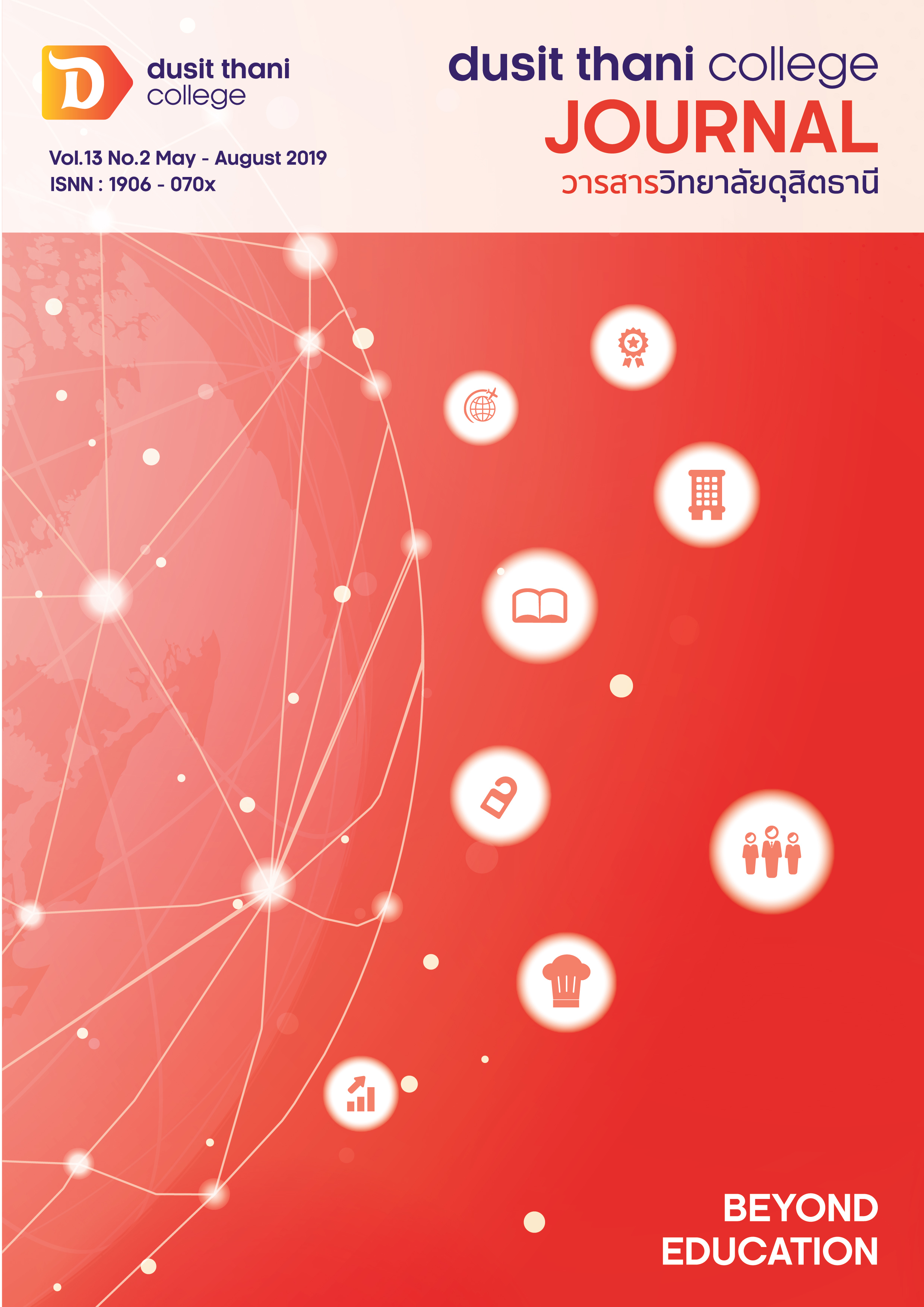รูปแบบการท่องเที่ยวเชิงอาหารพื้นถิ่นชายฝั่งทะเลภาคตะวันออก
Main Article Content
บทคัดย่อ
การท่องเที่ยวกับอาหารเป็นสิ่งที่แทบจะแยกออกจากกันไม่ได้ เนื่องด้วยพฤติกรรมของนักท่องเที่ยวส่วนใหญ่เมื่อมีการเดินทางท่องเที่ยวก็ต้องการที่จะลิ้มลองรสชาติของอาหารในท้องถิ่นนั้น อาหารจึงถือเป็นหนึ่งในกิจกรรมหลักของนักท่องเที่ยว รูปแบบการท่องเที่ยวเชิงอาหารพื้นถิ่นเป็นการแสดงให้เห็นถึงองค์ประกอบสำคัญของการท่องเที่ยวเชิงอาหารพื้นถิ่น โดยมีวัตถุประสงค์เพื่อสัมผัสรสชาติอาหารพื้นถิ่น เรียนรู้ถึงประวัติความเป็นมา วัฒนธรรม และเคล็ดลับการทำอาหารของสถานที่นั้นๆ โดยมีผู้เชี่ยวชาญด้านอาหารและเครื่องดื่มของแต่ละท้องถิ่นเป็นผู้อธิบายสิ่งต่างๆ และอาจจะมีคู่มือกิจกรรมหรือการลงมือปฏิบัติร่วมด้วย การสังเคราะห์รูปแบบการท่องเที่ยวเชิงอาหารพื้นถิ่นชายฝั่งทะเลภาคตะวันออก ประกอบด้วยองค์ประกอบย่อย 6 องค์ประกอบ ได้แก่ แหล่งท่องเที่ยว ชุมชนท้องถิ่น วิถีชีวิตและวัฒนธรรม อาหารการกิน กิจกรรม และเทคโนโลยีสังคม และองค์ประกอบร่วม 4 องค์ประกอบ ได้แก่ ศักยภาพของพื้นที่ การมีส่วนร่วมของชุมชน ปัจจัยภายใน และปัจจัยภายนอก
Article Details
นโยบายการพิจารณากลั่นกรองบทความ
- บทความวิจัยและบทความวิชาการทุกเรื่องที่จะได้รับการตีพิมพ์ต้องผ่านการพิจารณากลั่นกรองโดยผู้ทรงคุณวุฒิ (Peer Review) ในสาขาที่เกี่ยวข้อง จำนวน 3 ท่าน/บทความ
- บทความ ข้อความ ภาพประกอบและตารางประกอบที่ลงตีพิมพ์ในวารสารเป็นความคิดเห็นส่วนตัวของผู้เขียน กองบรรณาธิการไม่จำเป็นต้องเห็นด้วยเสมอไป และไม่มีส่วนรับผิดชอบใด ๆ ถือเป็นความรับผิดชอบของผู้เขียนแต่เพียงผู้เดียว
- บทความที่จะได้รับการตีพิมพ์จะต้องไม่เคยตีพิมพ์ เผยแพร่ที่ใดมาก่อน และไม่อยู่ระหว่างการพิจารณาของวารสารฉบับอื่น หากตรวจสอบพบว่ามีการตีพิมพ์ซ้ำซ้อน ถือเป็นความรับผิดชอบของผู้เขียนแต่เพียงผู้เดียว
- บทความใดที่ผู้อ่านเห็นว่าได้มีการลอกเลียนหรือแอบอ้างโดยปราศจากการอ้างอิง หรือทำให้เข้าใจผิดว่าเป็นผลงานของผู้เขียน กรุณาแจ้งให้กองบรรณาธิการวารสารทราบจะเป็นพระคุณยิ่ง
เอกสารอ้างอิง
2. Designated Areas for Sustainable Tourism Administration (Public Organization). (2016). Gastronomy Tourism. Bangkok: Office of the Prime Minister.
3. Hall, C. M. (2003). Wine, food and tourism marketing. The Haworth Hospitality Press:
New York.
4. Hsieh, A. & Chang, J. (2006). Shopping and Tourist Night Markets in Taiwan. Tourism Management 27, 3: 138–145.
5. Leejeerajumnean, Arunsri et al., (2016). Development of travelling routes for gastronomic tourism in western region of Thailand. Bangkok: The Thailand research fund.
6. Long, L.M. (2004). Culinary Tourism. Lexington, KY: The University Press of Kentucky.
7. Nitiworakarn, Saruda. (2014). Thai Food: Cultural Heritage of the Nation. Academic Journal Phranakon Rajabhat University, 5(1), 171-179.
8. Pakdeeaksorn, Panuwat. (2012). Tourism Motivation Theory and Food Tourism. Journal of Management Sciences, 29(2), 129-148.
9. Rand, G.E. du and E. Heath. (2006). Towards a framework for food tourism as an element of destination marketing. Current Issues in Tourism, 9(3), 206-234.
10. Sonwai, Sopark et al., (2016). The study of new Thai food as potential souvenir and their product development for gastronomic tourists. Bangkok: The Thailand research fund.
11. Siripis, Maltika et al., (2016). Development of travelling routes for gastronomic tourism in western region of Thailand. Bangkok: The Thailand research fund.
12. TAT Review Magazine. (2017). Foodie Experience. Bangkok: Tourism Authority of Thailand.
13. The Office Strategy Management. (2013). Eastern Region Development Plans (2014-2017). Bangkok: Ministry of Interior.


